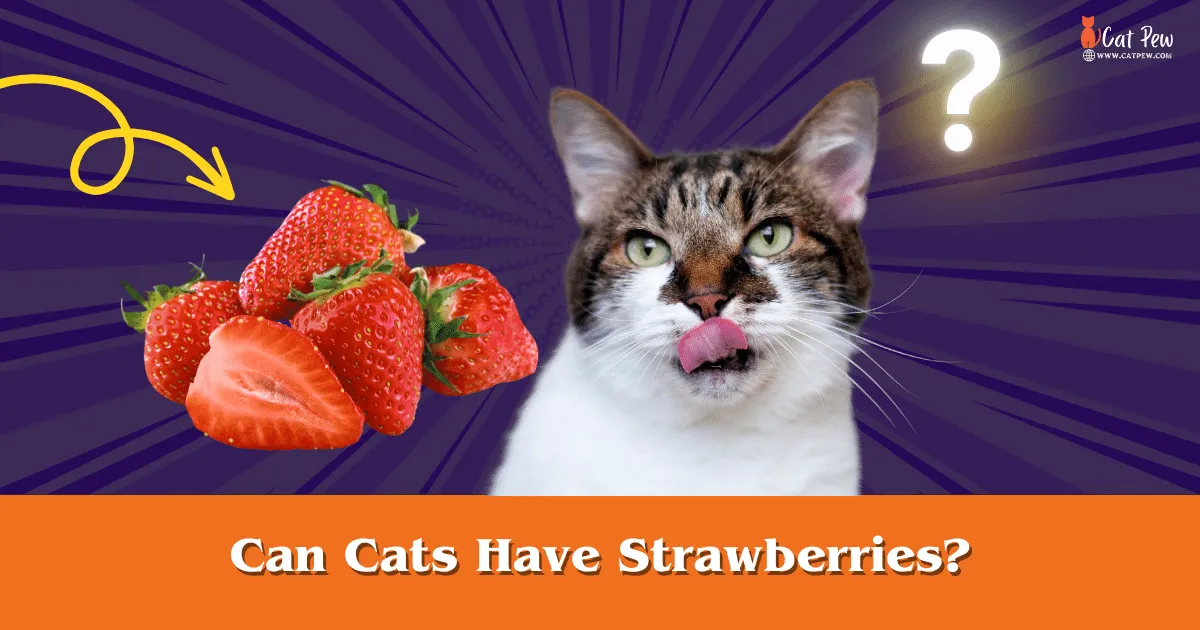Can Cats Have Strawberries?
Cats can have strawberries in moderation. These fruits are non-toxic to felines but offer minimal nutritional benefits.
Strawberries can be a low-calorie, healthy treat for your cat, offering a bit of variety to their diet. Rich in antioxidants, fiber, and vitamin C, they sometimes appeal to a cat’s curious taste buds. But remember, cats are obligate carnivores, meaning most of their dietary needs are met through meat consumption.
Fruits like strawberries should never replace their regular, balanced meals. Since felines lack sweet taste receptors, their enjoyment of strawberries might not be for the fruit’s sweetness but for its moisture and texture. Always slowly introduce any new food item, including strawberries, to your cat’s diet and pay close attention to any adverse reactions. Removing the stems and leaves, washing the fruit thoroughly, and serving it in small, chewable pieces to prevent choking hazards is crucial. Safety and moderation are essential when treating your pet to any human food.
Cats’ Taste Perception Explained

When delving into the world of feline gastronomy, it’s quite common to wonder which human foods are safe for our four-legged companions. Among such curiosities, a question often arises: Can cats have strawberries? Interestingly, this query opens up a larger discussion about the unique aspects of cats’ taste perception. Understanding what cats can taste can explain why certain foods might be more appealing or indifferent to our feline friends.
Understanding The Feline Sense Of Taste
Cats have a different sensory world compared to humans, and their sense of taste is no exception. With a mere 470 taste buds, cats have significantly fewer than humans who boast around 9,000. This reduced number implies a less nuanced perception of flavors, which steers their dietary preferences to textures and scents over taste diversity. Interestingly, cats are obligate carnivores, which means that their diet naturally revolves around meat consumption and, as such, has shaped their taste capabilities accordingly.
- Preference for meats: Cats are hardwired to crave amino acids present in meat, like taurine.
- Lack of sweet receptors: Interestingly, felines lack the taste receptor for sweetness, which is typically triggered by sugars found in fruits like strawberries.
How Cats’ Taste Receptors Differ From Humans’
The taste receptor landscape in cats contrasts significantly with that of humans. One of the most profound differences is that cats have a mutation in one of the key genes responsible for detecting sweet tastes. This difference is a likely reason why cats, unlike humans, may show little to no interest in sugary foods. Their sensory toolkit is honed for a carnivorous diet, which also may lead to inquiries such as “Can cats eat blueberries?” While these fruits are not toxic to cats, their taste buds may not register the sweet flavors humans enjoy.
| Taste Receptor | Cats | Humans |
|---|---|---|
| Sweet | Non-functional | Functional |
| Salty | Less sensitive | More sensitive |
| Sour | Similar sensitivity | Similar sensitivity |
| Bitter | Highly sensitive | Less sensitive |
| Umami | Functioning (meat flavors) | Functioning |
Given the differences in taste perception, some cats might nibble on strawberries out of curiosity, attracted by their color or texture, but they do not seek out fruits for sweetness. As obligate carnivores, their palate is more attuned to flavors that signal protein-rich foods, which is essential for their nutrition. While cats can safely enjoy certain fruits like strawberries and blueberries in moderation, their indifference to fruits’ sweetness often makes such foods less appealing.
Evaluating Strawberry Nutrients
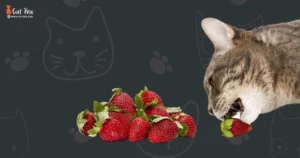
Cats are widely known for their carnivorous diet, but pet owners often wonder about the potential for including fruits, such as strawberries, as a treat. Diving into the nutrient profile of strawberries can help us understand if these sweet berries can be a healthy snack for our feline friends. It’s not just strawberries that captivate the curiosity of cat owners; similar questions like “Can cats eat blueberries” often arise. Before incorporating any human food into your cat’s diet, it’s critical to evaluate the nutritional benefits and potential drawbacks.
Identifying Vitamins And Minerals In Strawberries
Strawberries are rich in various vitamins and minerals that are beneficial for humans. But what about cats? Let’s break down the key nutrients found in these berries:
- Vitamin C: An antioxidant that supports the immune system.
- Manganese: Essential for bone development and energy metabolism.
- Fiber: Promotes a healthy digestive system.
- Folate (Vitamin B9): Aids in cellular growth and function.
- Potassium: Necessary for proper nerve and muscle function.
Comparing Feline Dietary Requirements
Understanding a cat’s dietary needs is essential when considering the inclusion of fruits like strawberries in their diet. Unlike humans, cats are obligate carnivores, meaning their nutritional needs are primarily met through consuming animal-based proteins. This distinct dietary requirement shapes how we should view the provision of fruits for cats.
| Nutrient | Benefits in Felines | Required in Diet? |
|---|---|---|
| Vitamin C | Cats produce their Vitamin C | No |
| Manganese | Needed in trace amounts | Yes |
| Fiber | Useful but not a dietary essential | No |
| Folate (Vitamin B9) | Required, but usually sufficient in a meat-based diet | Yes |
| Potassium | Essential for proper function | Yes |
When evaluating the nutritional components of strawberries, it’s crucial to note that while some vitamins and minerals may be beneficial, they are not necessary additions to a cat’s diet. Protein from animal sources remains the cornerstone of feline nutrition. Nonetheless, occasional treats like strawberries can be offered safely and may provide a novelty of texture and taste for your pet, as long as they’re given in moderation and without added sugars or chemicals that can be harmful to cats.
Risks Of Feeding Cats Strawberries
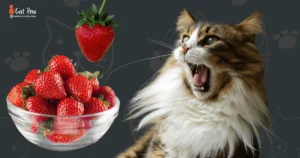
Exploring the feline diet can often lead to questions about which human foods are safe for cats to consume. While strawberries are not toxic to cats, incorporating them into your cat’s diet comes with certain risks. Understanding these potential health concerns is crucial for any cat owner considering sharing this sweet treat with their feline friend.
Potential Hazards Of Strawberries For Cats
Strawberries are often admired for their sweet taste and nutritional benefits for humans. However, cats process foods differently than humans, and strawberries may pose several risks:
- Digestive issues: Even though cats might enjoy the taste, strawberries could lead to gastrointestinal upset, including diarrhea or constipation.
- High sugar content: The natural sugars found in strawberries, while safe in small amounts, can be harmful to cats, particularly if they lead to obesity or contribute to the development of diabetes.
- Pesticides and chemicals: Strawberries could be coated with toxic pesticides and chemicals by cats. Always wash them thoroughly before offering a small piece to your pet.
- Choking hazard: Large pieces of strawberry can become a choking hazard. It’s crucial to cut them into appropriate sizes if you choose to feed them to your cat.
Signs Of An Allergic Reaction To Be Aware Of
While uncommon, cats can have an allergic reaction to strawberries. Immediate veterinary attention is vital if you notice any of the following signs after your cat consumes strawberries:
| Sign | Description |
|---|---|
| Hives or skin irritation | Look for unusual bumps or redness on the skin |
| Swelling | Swelling can occur around the face, particularly the lips and eyelids |
| Gastrointestinal distress | Symptoms may include vomiting or diarrhea |
| Difficulty breathing | Wheezing or coughing could indicate a severe reaction |
| Sneezing or coughing | Respiratory reactions might be a sign of an allergy |
Cats exhibiting any of these symptoms should be taken to the vet immediately. An allergic reaction can be dangerous and requires prompt medical attention.
Appropriate Strawberry Portions
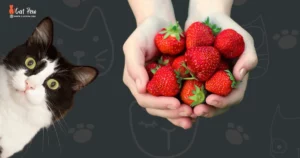
When considering adding a juicy treat like strawberries to your cat’s diet, understanding the proper serving size is crucial to ensure your feline friend’s health and enjoyment. Strawberries are not toxic to cats but should be considered a treat rather than a staple. Too much of anything, even a seemingly healthy fruit, can cause digestive upset or unwanted weight gain in pets. Let’s explore how to determine the safe quantity and frequency of strawberry treats for your kitty.
Determining How Much Is Safe For Cats
The ideal serving size of strawberries for your cat may vary depending on your cat’s size, activity level, and overall health. A general rule of thumb is to keep treats, including strawberries, to less than 10% of your cat’s daily caloric intake. This might mean one or two small strawberry pieces for an average-sized cat.
It’s always best to start with a tiny amount to see how your cat reacts. Some cats may have sensitive stomachs, and even a small piece of strawberry could cause gastrointestinal issues. Consult your veterinarian for personalized advice, particularly if your cat has diabetes-related health issues.
Frequency Of Feeding Strawberries To Your Cat
As with any treat, moderation is key. Feeding your cat strawberries should be a sparse occurrence, not a regular part of their diet. An appropriate guideline is to offer strawberries as a special treat at least once a week. This helps prevent the novelty from wearing off and ensures that your cat’s main nutrition still comes from their balanced, cat-specific diet.
Remember, every cat’s digestive system is unique, and some may handle strawberries differently than others. Keep a close eye on your cat after introducing any new food, and if you notice any changes in their behavior or digestion, it’s best to discontinue the treatment and consult your vet.
| Size of Cat | Max Strawberry Size | Frequency |
|---|---|---|
| Small | One Small Piece | Once a Week |
| Medium | One or Two Small Pieces | Once a Week |
| Large | Two Small Pieces | Once a Week |
Adhering to these guidelines will help keep your cat safe and happy while indulging in a fruity treat. Enjoy watching your cat experience new flavors, but always prioritize their health and well-being.
Steps To Introduce Strawberries

Curious felines often show interest in the foods their human companions enjoy. Strawberries, with their tantalizing aroma and bright red appearance, can be particularly intriguing to cats. While these juicy fruits are generally safe for feline consumption in moderation, introducing them properly is crucial to ensure your pet’s well-being. Let’s explore the steps to introduce strawberries to your cat’s diet safely.
Washing And Cutting Techniques
Cleanliness and size matter when it comes to offering strawberries to your furry friend. Follow these simple steps:
- Rinse each strawberry under cold running water to remove any pesticides or contaminants.
- Pat them dry with a clean towel to avoid any mushiness or excess moisture.
- Remove the leaves and stems, as these parts are not recommended for cats.
- Chop the strawberries into small, bite-sized pieces to prevent choking and aid digestion.
Monitoring Your Cat’s Initial Reaction
Observing your cat’s reaction to their first strawberry encounter is essential. Here are important aspects to note:
- Offer a small piece of strawberry as a starting point and watch for any signs of gastrointestinal upset.
- Check for signs of interest or distaste; not all cats will like the taste or texture of strawberries.
- Inspect for any allergic reactions, such as excessive scratching or difficulty breathing.
- If your cat enjoys the treat and shows no negative symptoms, strawberries can be gradually incorporated as an occasional snack in their diet.
Healthy Feline Treat Options
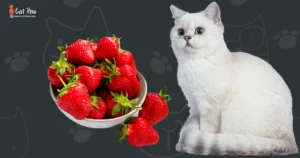
When it comes to pampering your feline friend with a special treat, it’s essential to choose options that are both safe and beneficial for their health. Many cat owners wonder about the suitability of certain fruits, such as strawberries, for their pets. While cats are primarily carnivorous, incorporating the occasional fruit treat can add variety and enjoyment to their diet. However, understanding which treats are both desirable and healthy for your cat is key to a balanced diet.
Comparing Strawberries To Other Cat-friendly Treats
Strawberries can be a refreshing, low-calorie option for cats, rich in antioxidants, fiber, and vitamin C. Nevertheless, these sweet treats should be given in moderation. Other cat-friendly treats like commercial catnip or freeze-dried meats might align more with their natural dietary needs. Here’s how strawberries stack up against other common treats:
| Treat | Benefits | Considerations |
|---|---|---|
| Strawberries | Antioxidants, Fiber, Vitamin C | Occasional treat, small portions |
| Freeze-Dried Meats | High Protein, No Additives | Close to natural prey diet |
| Catnip | Stimulates Play, Non-caloric | Not all cats are responsive |
It’s important to note that any treatment should only constitute a small percentage of your cat’s total caloric intake to prevent obesity and nutritional imbalance.
Viable Substitute Snacks For Cats
For those seeking alternatives to strawberries or other fruits, there are plenty of safe and nourishing snacks to consider. Aim for treats that cater to a cat’s carnivorous diet to maintain a healthy balance. Here are some substitute snacks to keep in mind:
- Cooked Meat: Small pieces of chicken, turkey, or lean beef, cooked without seasoning, are excellent protein sources.
- Fish: Cooked salmon or tuna, in moderation, can provide omega-3 fatty acids beneficial for a cat’s coat and joint health.
- Cat Grass: A safe plant-based option that aids digestion and provides fiber. It’s different from outdoor grass, which may be treated with chemicals.
- Commercial Cat Treats: Choose high-quality treats explicitly designed for feline health, focusing on those with limited ingredients and no fillers.
Always remember to introduce new treats gradually and monitor your cat for any adverse reactions. Consult with a veterinarian before adding any new elements to your cat’s diet, particularly if they have preexisting health conditions.
Complete Feline Diet Essentials

Welcome to the fascinating realm of Complete Feline Diet Essentials. As a pet parent, providing a nutritious and well-rounded diet for your beloved cat is paramount for their health and happiness. While an occasional strawberry might sound like a cute treat, understanding the core pillars of feline nutrition will ensure your furry friend thrives. Let’s dive into what makes a balanced cat diet and how occasional treats, like strawberries, can fit in.
Core Components Of A Balanced Cat Diet
A cat’s diet must deliver essential nutrients that support their overall health. Cats are obligate carnivores, requiring certain amino acids and vitamins that are found abundantly in meat. Here’s what a balanced cat diet should include:
- Protein: The centerpiece of cat nutrition – usually sourced from meats like chicken, turkey, fish, or beef.
- Fats: Essential for energy and absorption of vitamins – look for omega-3 and omega-6 fatty acids.
- Carbohydrates: Cats require little; however, digestible carbs can be an energy source.
- Vitamins and Minerals: Necessary in appropriate amounts for various bodily functions.
- Water: Ample hydration is critical since cats tend not to drink enough water.
These nutritional components should come from high-quality sources, explicitly designed for cats, with minimally processed ingredients. A discussion with a veterinarian can guide the best choices for your cat’s age, size, and specific health needs.
How Treats Fit Into A Cat’s Nutrition Plan
Treats add variety and enjoyment to a cat’s diet, but they should be just that—a treat. Here’s how to include them:
- Occasional: Treats should constitute no more than 10% of a cat’s total caloric intake to avoid nutritional imbalance and weight gain.
- Safe: Ensure any treat, including strawberries, is safe for feline consumption. Small, bite-sized pieces are recommended.
- Nutritious: Opt for treats that provide additional health benefits, like dental health or added fiber.
- Rewarding: Use treats as a positive reinforcement tool during training or to encourage good behavior.
Strawberries can be a fun, occasional treat for cats, but given their unique dietary needs, always consult with your vet before introducing any new food items. Remember, treats are supplementary and should never replace a meal.
Fruits Cats Can And Can’t Eat

Fruits Cats Can and Can’t Eat: As a cat owner, you might wonder whether sharing a piece of your favorite fruit with your feline friend is a good idea. While cats are carnivorous by nature, certain fruits can be a healthy treat. However, not all fruits are safe, and it is crucial to distinguish between those that are and are not.
List Of Cat-safe Fruits Vs. Toxic Ones
Sifting through what’s safe and what’s harmful to your cat is essential to prevent any health issues. Below is a tailored list that categorizes various fruits into ‘safe’ and ‘toxic’ for our feline companions.
| Cat-Safe Fruits | Toxic Fruits |
|---|---|
| Strawberries (in moderation) | Grapes and Raisins |
| Blueberries | Cherries |
| Watermelon (seedless) | Citrus fruits (i.e., Lemons, Limes) |
| Cantaloupe | Tomatoes |
| Bananas (sparingly) | Avocado |
Guidelines For Feeding Human Food To Cats
When it comes to treats like fruits, moderation is key. Overindulgence can lead to digestive issues or an imbalance in your cat’s diet. To ensure you’re offering treats safely, follow these general guidelines:
- Introduce new foods gradually to avoid stomach upset.
- Consult your veterinarian before adding human food to your cat’s diet, especially if they have underlying health conditions.
- Wash all fruits thoroughly to remove pesticides and cut them into small, manageable pieces to prevent choking.
- Limit treats to 10% of your cat’s daily caloric intake to maintain a balanced diet.
- Observe your cat after introducing a new fruit to ensure they don’t have an adverse reaction.
Remember, even cat-safe fruits can lead to obesity and other health issues if not given in moderation. Stick to the safety guidelines above to make fruity treats a delightful and rare surprise for your furry friend.
Frequently Asked Questions For Can Cats Have Strawberries
Can Cats Eat Strawberries?
Yes, in moderation. Strawberries are safe for cats to eat as an occasional treat.
Are Strawberries Toxic To Cats?
No, strawberries are not toxic to cats and can be given as an occasional treat.
Are Strawberries Safe For Cats To Eat?
Yes, strawberries are generally safe for cats in moderation. They’re non-toxic, but they should be given as a treat rather than part of the daily diet. As with any new food, introduce strawberries slowly to avoid digestive upset.
Can Kittens Eat Strawberries?
Kittens can have small amounts of mashed or pureed strawberries as a treat.
Can Cats Eat Strawberry Leaves?
It is best to avoid giving cats strawberry leaves as they may cause stomach upset.
Can Strawberries Benefit A Cat’s Health?
Strawberries contain antioxidants, fiber, and vitamins that can be beneficial for cats. However, these nutrients should come primarily from a cat’s regular diet. Strawberries can be an occasional, healthy treat in very small amounts.
How Should I Prepare Strawberries For My Cat?
Wash strawberries thoroughly to remove pesticides and cut them into small, bite-sized pieces to prevent choking. Removing the stems and leaves is best as they might cause digestive issues.
Why Do Cats Like Strawberries So Much?
Cats are attracted to the sweet smell of strawberries, and some may enjoy the texture and taste as well.
How Many Strawberries Can A Cat Have?
Cats should only have strawberries in very small quantities—a couple of pieces or one strawberry cut up is plenty. Treats should comprise no more than 10% of a cat’s daily caloric intake.
Are There Any Risks Associated With Feeding My Cat Strawberries?
Some cats may have allergies or sensitivities to strawberries, so it’s important to monitor your cat after introducing this new food.
Conclusion Of Can Cats Have Strawberries
To wrap it up, when given in moderation, strawberries can be a sweet treat for your feline friends. Always remove the stems and leaves, and introduce them slowly to your cat’s diet. Remember to monitor for any adverse reactions. As a pet owner, ensuring your kitty’s health and happiness with safe snacking options like strawberries can add a little variety to their life.
Keep those purrs coming with healthy choices!

Winston
I'm Winston, the author of this feline-focused (Catpew.com) blog . My love for cats goes back to my childhood, when I spent countless hours playing with my family's tabby, Mittens. This furry friend instilled in me a deep appreciation for the unique personalities, playful nature, and unconditional love that cats offer.

